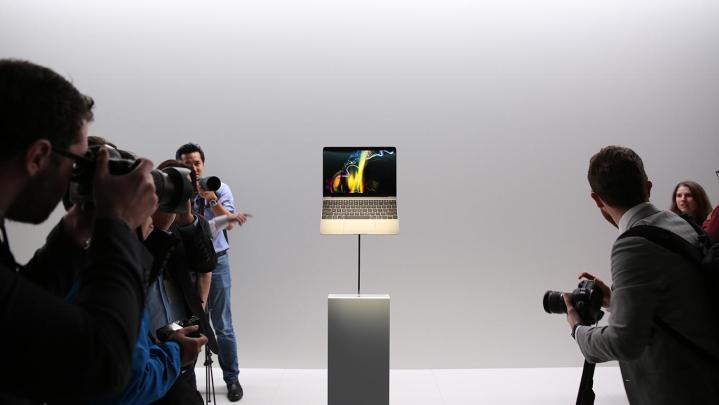
War on ports
Ports have been under threat for several years. The original Air was arguably the first move against them, as it famously ditched all but one USB port in an era where most systems had at least four.
In doing so it earned itself a great deal of scorn, and Apple did reverse course slightly by expanding connectivity with the 2010 redesign (though it was still barren by the standards of its era). Yet the rest of the industry relented and followed suit with Intel’s introduction of the Ultrabook.
The Ultrabook label isn’t uttered much anymore, largely because it’s become redundant. What was once a premium Ultrabook is now just a premium notebook. Intel wanted notebooks to become thinner, and to embrace low-voltage processors; both goals have been achieved. With the exception of gaming systems, luxury laptops are no longer allowed to be thick. That’s a victory for Apple in the war on ports.

The new MacBook continues that war. It attempts to make the difference between ports irrelevant by boiling them all down to a single jack, which isn’t even labeled. In this way it attempts to declare the death of wired standards entirely. To the MacBook owner there’s no difference between ThunderBolt, HDMI and USB. It’s all the same plug in the end.
Back in 2008, virtually every review cited the lack of ports as one of the original Air’s major oversights. Today, its connectivity is commonplace on every new notebook, Windows, Mac or Chromebook, with an 11-inch to 13-inch display. It felt odd, even handicapped, back then, but the Air was prophetic.
Is the future now?
A prophetic feature isn’t always a good one, though, at least not at the time it’s released. The original Air’s limited connectivity was in fact a problem, even if it was also the wave of the future. Reviewers were right to note that users couldn’t connect an external keyboard and mouse at once, that the single video port wasn’t the type used by most displays, and that the location of the ports made it difficult to connect some devices.
The new MacBook attempts to declare the death of wired standards entirely.
A prophetic feature isn’t always a good one.
Now we have the new MacBook, which takes an equally bold approach, and will encounter similar problems. The do-it-all port USB-C port is not one commonly used. Most of today’s hardware simply won’t connect to it without an adapter.
Apple’s trail-blazing approach is correct. Standards really are a pain in everyone’s ass. But is it too soon? That depends on the user, but for many people, the answer will be “yes.”
Storage is the most obvious problem: External USB drives will become a pain to use. Few people own wireless home network storage, particularly among the same “average” users who would likely enjoy a notebook with a single, do-it-all port. Cloud storage is readily available, but large volumes of it are expensive, and many people lack a broadband connection speedy enough to make the cloud an ideal backup location.
Heaven help you if you like to use multiple displays, which you can’t do while charging the MacBook right now. There will almost certainly be an adapter that handles this, but that’s a messy solution. Wireless video standards, like wireless storage, aren’t ready for prime time.

Intel does have a wireless standard, called WiDi, that could potentially handle this issue, but it’s not clear if OS X will support the standard. Even if it does, users will have to buy an adapter to convert their display, since monitors don’t have WiDi compatibility built in. There’s that word again – adapter. The number of adapters required to make the MacBook act like other notebooks will add up to more cost and complexity.
Approach with caution
The new MacBook is the future for Apple, and the computer industry as a whole. The company decided to name it “MacBook” without modifier because it intends for this system to become its mainstream notebook going forward. As hardware improves with each generation, the system will gain power, run cooler, enjoy better battery life, and reduce in price. One day, it’ll likely ditch every single port, opting for some form of wireless charging.
Apple’s trail-blazing approach is correct. Standards really are a pain in everyone’s ass.
Yet this is only 2015. There are thousands of devices vying for ports, many of which provide essential functions. Most people can’t throw all of their existing peripherals out the door and opt for Apple’s wireless solutions, such as iCloud storage and the AirPort Time Capsule. And while we’re sure that a dock will be invented, either by Apple or a third party, to expand connectivity while at a desk, that’s not the most elegant solution. Indeed, it defeats the entire point of a single, intuitive port.
The new MacBook is going to be the most beautiful and most intuitive notebook to ever land in consumer’s hands, and you may well love it. Before pulling the trigger, though, you’ll have ask yourself: Can you handle the future?
Editors' Recommendations
- These 6 tweaks take MacBooks from great to nearly perfect
- The biggest threat to the MacBook this year might come from Apple itself
- Why you should buy a MacBook Pro instead of a MacBook Air
- Why you should buy a MacBook Air instead of a MacBook Pro
- I needed to buy a new MacBook. Here’s why I bought a power bank instead


